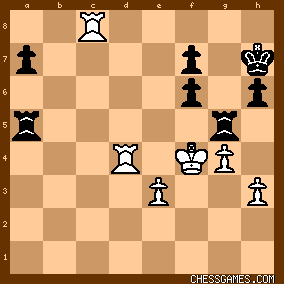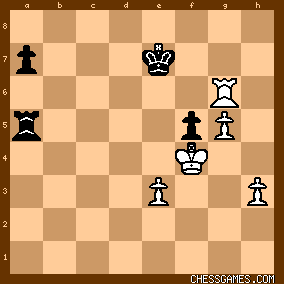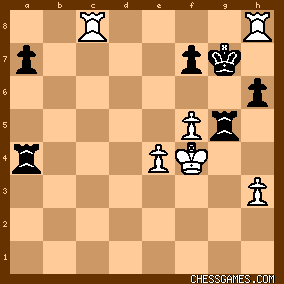|
< Earlier Kibitzing · PAGE 3 OF 3 ·
Later Kibitzing> |
| Apr-18-10 | | johnlspouge: Sunday (Insane)
Marshall vs Kupchik, 1913 (29.?) White to play and win.
Material: Down a P. The Black Kh7 has 1 legal move, suggesting that White should play Rd4-d8, to double Rs on the 8-th rank for a mate. Black can play Pf6-f5, to give his Kh7 a flight square, however. The candidate 29.e4 restrains Pf6. White can also advance Ph3-h4-h5 with tempo, if he wishes to constrain Ph6.The White Kf4 is presently secured from all but pointless checks from f5. Candidates (29.): Rdd8, e4, h4
29.Rdd8
(1) 29…f5 30.Rh8+ Kg7 [or Kg6]
31.Rcf8+ Kf6 32.Rxh6+ Rg6 33.g5+ Ke7 [Ke6 is similar] 34.Rhxg6 fxg6 35.Rxg6
White has connected outside passers and a superior K position, so he should win. (2) 29…Ra4+ 30.e4
The play is similar, except the Black Pf6 is vulnerable. I missed the game defense 29…Rg7, but Toga likes 29…f5 better. |
|
| Apr-18-10 | | sethoflagos: If it was black's move, I think Rg8 would be likely, breaking up the threat of the doubled rooks on the 8th rank. This weighs against the selection of preparatory moves like 29. h4. <29. Rdd8 ...> threatening 30. Rh8+ Kg2/3 31. Rcg8# Black has two possible options (except spite check Ra4+): Line 1:
<29. ... Rg7
30. Rh8+ Kg6
31. h4 ...> threatens 32. h5+ Rxh5 33. gxh5 Kxh5 <31. ... h5
32. gxh5+ Rxh5
33. Rxh5 Kxh5
34. Rh8+ Rh7> 34. ... Kh6 35. h5#
35. Rxh7> with winning material advantage
Line 2
<29. ... f5
30. Rh8+ Kg6/7
31. Rcg8+ Kf6
32. Rxh6+ Rg6> 32. ... Ke6/7 loses R
<33. g5+ Ke7
34. Rhxg6 fxg6
35. Rxg6>
With black's f-pawn falling to Rf6, white's pawn advantage is overwhelming. Spite checks from the remaining black rook (eg 34. ... Ra4+ 35. Kxf5)
only delay the inevitable. |
|
| Apr-18-10 | | Minty: Ugh. I looked at the whole line up to 31. Rh8+ Kg6 32. gxh5+ Rxh5, and thought there was nothing there. 33. Rxh5 Kxh5 34. Rh8+ and black must lose the rook to avoid mate. Bah! |
|
| Apr-18-10 | | sethoflagos: After <29. Rdd8 Rg7> most kibitzers seem to have gone with the game line of <30. h4 ...>, which I thought gave black more options than <30. Rh8+ Kh6 31. h4> Have I missed something? |
|
Apr-18-10
 | | tarek1: <goodevans>
When I said "ALL" line that was an exaggeration in the heat of the rant. Of course it's very difficult to see all lines in a reasonably complex puzzle ! most lines is good enough for me as it is for you. |
|
| Apr-18-10 | | johnlspouge: < <sethoflagos> wrote: After <29. Rdd8 Rg7> most kibitzers seem to have gone with the game line of <30. h4 ...>, which I thought gave black more options than <30. Rh8+ Kh6 31. h4> Have I missed something? >
Hi, <sethoflagos>. Toga agrees that 30.Rh8+ is better than 30.h4. |
|
| Apr-18-10 | | karnak64: Nice to see a proper Danish surname in one of the defenses to the Danish gambit. |
|
Apr-18-10
 | | OBIT: <tarek1 NO,NO,NO ! You solved the puzzle when you worked out ALL the relevant lines to the end ...> As as objective, "solving the puzzle" is way too linear for my taste. If you play your tournament games by trying to work out an airtight, irrefutable forced win every time it is your move and you don't dare move until you do, the clock is always your enemy. I've even had the experience of working out that airtight, irrefutable forced win and still losing because I didn't leave myself enough time to find the moves to win the won game. Now, if you approach these puzzles as an analytic exercise and you are moving the pieces around as you try to find the airtight win, fine -- analyzing positions is certainly one way to learn the game. However, if you are trying to work out the whole thing in your head, then the question you are really asking yourself is, "If this position came up in an actual game, how would I play it?" And, if OTB conditions are being simulated, I think the clock has to be part of the equation -- you have to make a decision in a reasonable amount of time. As for myself, I approach the puzzles, at least for the first pass, to see how much I can work out in my head in, say, 15 minutes. If I can pick the right move and have a general idea what the continuation should be, great. If the winning line is something totally different, even better, as that means I learned something. |
|
Apr-18-10
 | | An Englishman: Good Evening: I think both <tarek1> and <OBIT> are right, but it depends upon the puzzle. Sometimes, as with this puzzle, it is possible to figure out the entire line until the end--and therefore you must figure out the entire line to claim credit. However, some Sunday puzzles involve finding speculative or intuitive sacrifices that the player could not have analyzed until the end, which came 20 moves later. If you can come up with the first 4-5 moves of the key lines and "have a general idea what the continuation should be," as <OBIT> writes, I think that's good enough. |
|
| Apr-18-10 | | Jack Kerouac: Jack Kerouac states,"God was gone; it was the silence of his departure.It was a rainy night. It was the myth of the rainy night. Neal was popeyed with awe. This madness would lead nowhere. I didn't know what was happening to me, and I suddenly realized it was only the T that we were smoking, Neal had bought some in New York. It made me think that everything was about to arrive- the moment when you know all and everything is decided forever."
P-K4- "Best by test."- Fischer |
|
| Apr-18-10 | | Eduardo Leon: White to play. 29.?

click for larger view<29.♖dd8>
If <29...♖g7>, then <30.♖h8+ ♔g6 31.h4 h5 32.gxh5+ ♖xh5 33.♖xh5 ♔xh5 34.♖h8+>, and white wins a rook, since 34...♔g6 allows 35.h5#. 
click for larger viewIf <29...f5>, then <30.♖h8+ ♔g(any) 31.♖cg8+ ♔f6 32.♖xh6+ ♖h6 33.g5+ ♔e7 34.♖(any)xg6+ fxg6 35.♖xg6>, with a winning endgame. 
click for larger viewIf <29...♖a4+? 30.e4 f5>, then <31.♖h8+ ♔g7 32.gxf5>, with two threats: 33.h4 ♖g(any) 34.♖(any)g8+ and 33.♖cg8+ ♔f6 34.♖xh6+, in both cases, winning a rook. 
click for larger viewThe only way to save the rook is <32...f6>, but that allows <33.♖hd8!> and mate is unavoidable, for example: 33...h5 34.♖(any)7+ ♔h6 35.♖h8+. 
click for larger view |
|
| Apr-18-10 | | Eduardo Leon: <tarek1: You solved it if and only if you can EXPLAIN and JUSTIFY why this is the move. This is how I see puzzle-ethics, no just a vague glance at a position and... haha, I found ! NO,NO,NO ! You solved the puzzle when you worked out ALL the relevant lines to the end, refuted obvious AND non-obvious defenses, when you saw the hidden blows buried deep in the variations !> Agreed. Even if you missed only a tiny relevant line, you have <NOT> solved the puzzle. |
|
Apr-18-10
 | | chrisowen: 29.Rd8 poor Joe, black knows with general daftness it holds Kupchik. Ok now pour froth f5 not Rg7 doughnut. Fed up a backward rook strips again defence. The fee, cough up rook. Ra5 was the lemon, again Frank Marshall surely teases. Press o double rooks mates him. Only two death for Kupchik in the database. |
|
| Apr-18-10 | | sethoflagos: <Eduardo Leon: Agreed. Even if you missed only a tiny relevant line, you have <NOT> solved the puzzle.> So all of us who failed to jot down a definitive proof that the tiny but relevant line 29. Rdd8 Rxg4+ ultimately led to forced mate are failures by your high standards, are we Eduardo? ;-) |
|
| Apr-18-10 | | msingleton: New Player apologize if this isn't a good question. Move 28 for white if he felt he was in a good position wouldn't it have been better for him to play e4. This doesn't jepardize a rook swap and black a better chance for at least a draw? |
|
| Apr-18-10 | | gofer: Okay, so this is two days in a row where the answer seems way to obvious...
...this time its "gain control of the back rank"! It puts black in a totally
defensive position, where they have to start dropping crucial pawns! 29 Rdd8 ...
The obvious threat of 30 Rh8+ Kg7/Kg6 31 Rcg8# is difficult to avoid. 29 ... Ra4+
30 e4 just delays the same continuations and if anything puts black in a worse
position! So black must deal with this and Rg7 and f5 are the only options. Option 1
========
29 ... Rg7
30 Rh8+ Kg6
31 h4 ...
31 ... Rh7
32 Rcg7+ Rg7
33 h5+ Rxh5
34 gxh5+ Kxh5
35 Rxg7 a5
36 Kf5 a4
37 Rg1 Kh4 (a3 38 Rh1#)
38 Rxh6#
31 ... f5
32 Rc6+ f6
33 h5+ Kf7
34 Rc7+ Kd6
35 Rxg7 winning
31 ... h5
32 gxh5+ Rxh5
33 Rxh5! Kxh5
34 Rh8+ Rh7 (Kg6 35 h5#)
35 Rxh7+ Kg6
36 Rh8 Kg7 (stopping Rg8+ mating very quickly)
37 Ra8 a5
38 Kf5 a4
39 Rxa4 Kf8
40 Kxf6 Kg8 (Ke8 41 Rd4 Kf8 42 Rd8#)
41 Ra8+ Kh7
42 h5/d4 etc Kh6
43 Rh8#
Option 2
========
29 ... f5
30 Rh8+ Kg6/Kg7
31 Rcg8+ Kf6
32 Rxh6+ Rg6 (Ke7 Rxg5 winning)
33 g5+! Ke7
34 Rhxg6 fxg6
35 Rg7+ (adding insult to injury!) Kf8
36 Rxg6 ...
Now its all over...
Time to check... |
|
| Apr-18-10 | | rossvassilev: I always figure out the "insane" ones but have trouble with the "easy" ones. Go figure. |
|
| Apr-18-10 | | Chess Network: Nice way to finish with a pawn delivering mate. :) |
|
| Apr-18-10 | | SamAtoms1980: The first move 29 Rdd8 was easy. I got as far as 29 ... f5 30 Rh8+ Kg7 31 Rcg8+ Kf6 32 Rxh6+ Rg6 33 g5+! Ke7 34 Rhxg6 fxg6 35 Rxg6 with a winning endgame up a pawn. But I did NOT see 29 ... Rg7 30 h4!! h5 31 Rh8+ Kg6 32 gxh5+ Rxh5 33 Rxh5 Kxh5 34 Rh8+ Kg6 35 h5#!!! |
|
| Apr-18-10 | | agb2002: White is a pawn down.
Black threatens 29... f5, trying to make effective the material advantage. The black king only has two columns to move. Therefore, 29.Rdd8, threatening mate in two: A) 29... f5 30.Rh7+ Kg7(6) 31.Rcg8+ Kf6 32.Rxh6+ Rg6 (32... Ke7 33.Kxg5) 33.g5+ Ke7 34.Rxg6 fxg6 35.Rxg6 followed by Rf6,
grabbing a second pawn or h4, h5, etc.
B) 29... Rg7 30.Rh8+ Kg6 31.h4
B.1) 31... h5 32.gxh5+ Rxh5 33.Rxh5 Kxg5 34.Rh8+ Kg6 35.h5#. B.2) 31... f5 32.Rc6+ f6 33.h5+ Kf7 34.Rc7+ Ke6 35.Rxg7 + -. B.3) 31... Rh7 32.h5 Raxh5 (32... Kg7 or 32... Rhxh5 33.Rcg8#) 33.gxh5+ and mate next. C) 29... Ra4+ 30.e4 doesn't seem to improve anything for Black. |
|
| Apr-18-10 | | agb2002: I forgot the pawn on h6 in my line B.3, it should read B.3) 31... Rh7 32.h5+ Rxh5 (32... Kg7 33.Rcg8#) 33.gxh5+ Kxh5 34.Rxh7 + -. Time to go to bed. |
|
| Apr-18-10 | | patzer2: <msingleton> I think 28. Rd4 is best. It's about an even position, but 28. Rd4 makes a threat and gives Black a chance to go wrong. In the game continuation, declining the exchange of rooks with 28...Raa5?? is the decisive mistake. If 28...Rxd4 29. exd4  Marshall has full compensation for Black's extra pawn. Marshall has full compensation for Black's extra pawn.However, that being said, there's nothing wrong with 28. e4 = except that after 28...Re5 = Black has no problems and White's winning chances are practically zero. |
|
| Apr-18-10 | | VincentL: Another rook and pawn position, "Insane".
Here, if white starts 29. Rdd8 mate is theatened. 30. Rh8+ Kg6/Kg7 31. Rcg8 mate I see only two defences. 29.... Rg7 or 29....f5,
(a) If 29.... Rg7 30. Rh8+ Kg6 31. h4
Now if 31.....f5 32. Rc6+ f6 33. h5+ Kf7 34. Rb8 and black has 34...Ra4+ White can try 32. g5 threatening 33. Rxh6 mate. But then 32....hxg5. 33. hxg5 and black again has the resource 33.....Ra4+ For the moment I am not making progress in this line. (b) 29....f5 30. Rh8+ Kg6 31. Rg8+ Kf6 and white is not making progress. This all suggests that white must start with some other move. Let's start 29. h4. Then after 29....Rg8 30. Rxg8 Kxg8 31. Rd8+ Kg7 and I don't see a
good way to continue.
My time has run out. Time to check. |
|
| Apr-18-10 | | VincentL: Ah... White should play h4 one move earlier. |
|
| Apr-19-10 | | tacticalmonster: 1) Black was up a passed A pawn. But his kingside was significantly weakened. He had doubled F pawns. 2) White was up a "king". His king aggressively placed on f4 attacking g5 rook, supporting his pawn push and cuting off retreat square of the Black king. White king was also perfectly safe where it was. 3) Black had weak eighth rank and one White rook was already ideally placed to take advantage of it. 4) Black g5 rook was oddwardly placed. It did not have many retreating squares. It was also vulnerable to attack by the pawn and king. 5) Black king was extremely exposed on the kingside. He had to play f5 to make a run toward the center. Candidate: R4d8 and e4
1 R4d8 f5 2 Rh8+ Kg7 3 Rcg8+ Kf6 4 Rxh6+ Rg6 5 g5+ Ke7 6 Rgxg6 fxg6 7 Rxg6 Ra1 8 Kxf5 a5 7 h4  1 e4 Rgc5 2 Ra8 f5!= |
|
 |
 |
|
< Earlier Kibitzing · PAGE 3 OF 3 ·
Later Kibitzing> |





